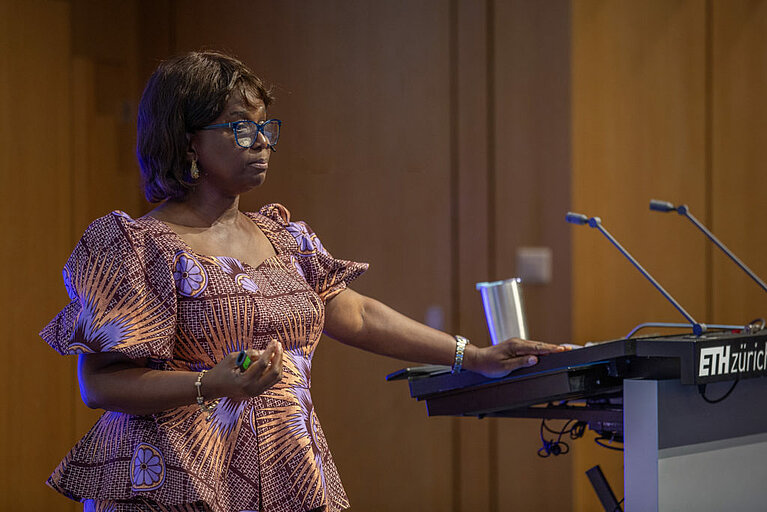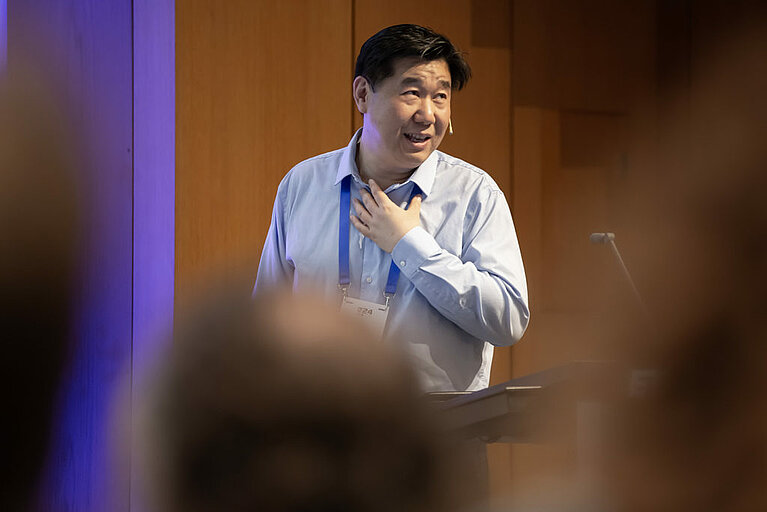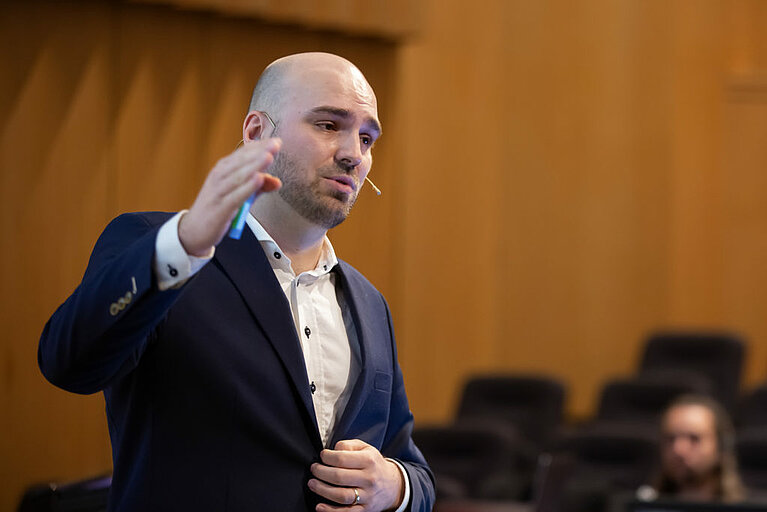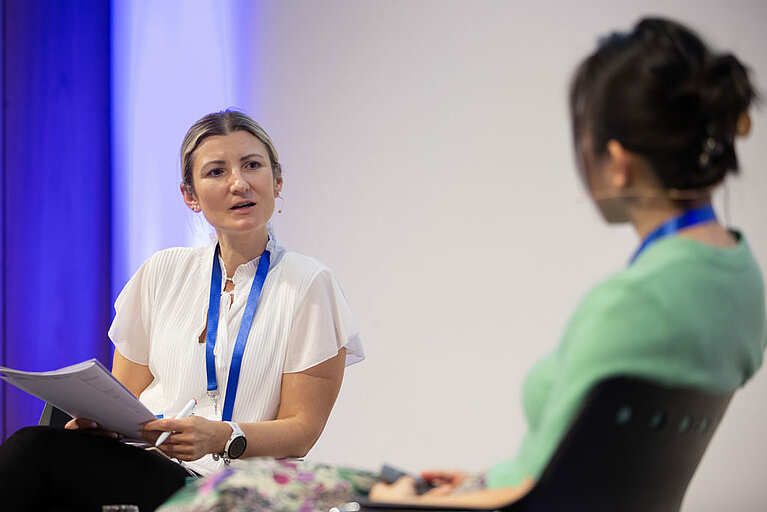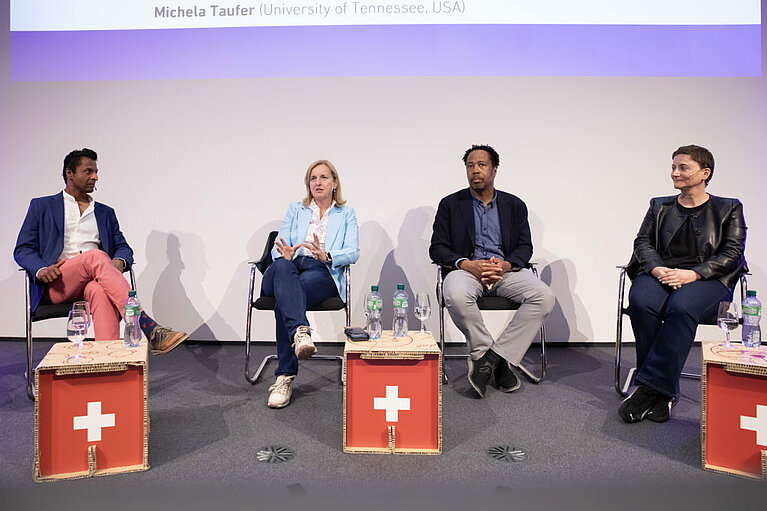June 21, 2024 - by Santina Russo
This year marked the PASC Conference’s ten-year anniversary. And to celebrate this milestone, members of the organising committee, including the two co-chairs Katherine Evans and Siddhartha Mishra, the conference’s coordinator Tatjana Ruefli, and other long-time members of the PASC community planned a special surprise befitting the occasion: To the amusement of the audience in the Audi Max lecture hall at ETH Zurich, at the end of the first day of the three-day event, the PASC crew launched into flash mob musical medley performance.
The song’s lyrics had been customized so as to playfully remind us all of the many ways in which the HPC community is committed to advance society: climate and weather scientists providing “forecasts to deal with extreme events;” material scientists focusing on “metals and composites to improve the quality of life;” biologists engaging in “unlocking secrets that genes might foretell so as to predict outcomes left to chance;” physicists “saving the Earth;” and social scientists wanting to “share a whole new world…where fairness is clear.” Lastly, the refrain and grand final invited the audience to “join this PASC!”
“This was really meant as a celebration of the vibrant PASC community and originated from the heart of the people involved,” said Ruefli, long-time event manager at CSCS who had initiated the musical flash mob and hired artistic director Maria Silvia Roli to create the medley based on the input of all performers who agreed to join the project.
The Power of PASC: Bridging Disciplines
The variety of disciplines being so prominent in the song was no coincidence: PASC24’s theme was “Synthesizing Applications Through Learning and Computing”, highlighting the importance of transcending domain boundaries to tackle multidisciplinary questions. “We wanted to build on the tradition of PASC to bring together researchers of different domains, applied mathematicians, and computer scientists,” said Katherine (Kate) Evans. Admittedly, interdisciplinarity is not new, and the term is sometimes trated as a mere buzz word. But, “Here at the PASC Conference, we can both see and promote the understanding and collaboration,” said the co-chair. “To meet and connect in person is extremely important for this. It broadens the view on one’s own research and makes exchange a lot easier.”
When putting together the conference program, Evans and her co-chair Siddhartha Mishra had in mind three focuses of interdisciplinarity: the connection of computing and machine learning (ML), opening up HPC for new areas and specialists, and the connection between scientific disciplines, such as climate and health sciences.
How a warming planet impacts human health
Again, it was no coincidence that the public lecture on the second day of PASC24 presented a research project at the intersection of computer simulation, global warming and health. The lecture presented by applied mathematician and associate professor at the University of Kansas Folashade Agusto, was entitled “Triple Whammy: Exploring the Effects of Prescribed Fire and Rising Temperature on Tick-Borne Diseases”, and shared research on the rising risk of tick-borne diseases like lyme disease in the warming climate. In fact, according to statistics of the US Centers for Disease Control and Prevention (CDC), cases of tick-borne diseases have more than doubled from 2004 to 2018 — from around 22,000 to over 47,000 affected people.
One way to mitigate the spread of ticks and diseases they carry, explained Agusto, is prescribed fires, meaning intentional fires necessary for land and forest management. She has investigated the effect of fire intensity on tick populations in different spatial scenarios like woods or grassland. To achieve this, she and her group developed an extended Lyme disease model that combines the ticks' spreading with fire-related population reduction and how well a tick population is already established in an area — all to address a health threat accelerated by climate change.
Marriages between physics and machine learning
The second focus of interdisciplinarity at PASC24 — the connection of computing and data-driven ML approaches —, ran through the entire program, starting with the conference’s first keynote lecture. Presented by Fei Sha, research scientist and head of an interdisciplinary group at Google Research, the talk explored how ML can accelerate simulation and scientific computing: How much can we learn from data when assuming little knowledge about the physics? How far can we go when, in contrast, physics and ML are closely combined? Sha shared several projects that assessed the combination of physical equations and data-driven ML models, concluding that the data-driven approaches mostly work and can improve the robustness of results, but they need customized ML designs. Furthermore, generative AI can provide a flexible trade-off among high-fidelity physics, statistical tolerance and computation.
A project that married physics and ML was also selected as ”PASC24 Best Paper”: the work by Ryan Sandberg, Axel Huebl, and colleagues at Lawrence Berkely National Laboratory entitled “Synthesizing Particle-In-Cell Simulations Through Learning and GPU Computing for Hybrid Particle Accelerator Beamlines”. In their presentation, Sandberg and Huebl explored laser-plasma accelerators, in which ultra-short laser pulses are used to generate plasma wakefields that accelerate charged particles. To investigate these wakefields, the scientists replaced certain steps of their large-scale particle-in-cell models with neural network models, thereby accelerating the simulations and making them computationally feasible in the first place.
The rise of ML in scientific computing
The combination of physics-based simulations and ML was also covered in many of the conference’s minisymposia. They explored, for instance, how AI-enhanced models were able to compute quantities that were not resolved by the grid of the physics-based models, how deep learning could help in cancer drug response prediction, how generative AI can help with materials design, or by which methods ML can be interfaced with numerical climate models.
Is ML revolutionizing science then? “It is certainly augmenting it,” said Evans. “The ideas about the potential of data-driven methods have been around for a while, but now we have the computing resources to bring the algorithms to life. Until now, when asking and answering scientific questions, we have relied on three pillars: theory, experiment, and simulation. With data-driven approaches, we now have a fourth tool to confirm as well as increase confidence in findings.” Evans emphasized that since the findings from ML models are more or less coming out of a black box, the underlying causes and processes need to be considered along with other pillars as well for results to be scientifically valid. “But ML can show us where to look and complete the view from a new perspective,” she added.
PASC anniversary in numbers
Chaired by Katherine Evans, Division Director for the Computational Sciences and Engineering Division at Oak Ridge National Laboratory, and Siddhartha Mishra, professor of computational and applied mathematics at ETH Zurich and a core faculty member of ETH AI Center, this year’s Platform for Advanced Scientific Computing (PASC) conference held from June 3 – 5 at ETH Zürich’s main building, was the biggest edition yet. For comparison: In 2014, the first PASC conference was attended by 265 researchers and computer and software engineers, with more than 80 percent of them based in Switzerland; now, ten years later, its size has nearly doubled to more than 500 participants, with more than 60 percent of them working in institutions outside of Switzerland.
On top of plenary sessions, which included three keynote presentations, a panel discussion and the interdisciplinary dialogue on bridging quantum and classical computing, PASC attendees could choose from over 180 talks in 49 minisymposia, 26 full research papers, and over 60 posters.
A dialogue to build bridges
A regular feature of the PASC Conference series was the Interdisciplinary Dialogue, this time featuring Nana Liu from Shanghai Jiao Tong University and University of Michigan as interviewee, and Florina Ciorba from University of Basel as interviewer. The topic was: “Bridging Quantum and Classical Computing: Insights into the Next Era of Interdisciplinary Science.” Ciorba began by emphasizing the need to integrate classical and quantum computing to push the boundaries of scientific discovery and Liu confirmed in her compelling short presentation: “We have reached the limit of classical infrastructure.” Liu’s presentation resonated with the audience, setting the tone for an engaging dialogue with Ciorba and the scientists present in the auditorium.
The third interdisciplinarity focus of the event — bringing new areas and specialists to computing and HPC, such as engineers, economists, or ethicists — was also emphasized in the minisymposia. Research dedicated to data democratization, ethical and societal considerations for scientific computing, and advances of deep learning in economics were all covered.
There was another premiere in this year’s conference: the PASC ACM Student Research Competition. The winner at PASC24 will get the chance to take part in a consecutive round of the competition, and, if they are successful, in the grand finals. Noteworthy: Until now, of the more than 20 conferences able to offer this ACM competition for students, only one was representing HPC. “That the PASC Conference has gained a place in this circle provides more visibility to young researchers in HPC, as well as a higher impact of HPC in the computing community,” stated Jay Lofstead, organizer of this competition at PASC24.
Let’s team up!
The conference’s final treat was the panel discussion on “Science as a Team Sport: How do we win together”. Panellists Ewa Deelman from the University of Southern California, Karthik Kashinath from NVIDIA, Damian Rouson from Lawrence Berkely Laboratory, and Michela Taufer from the University of Tennessee spoke about the role of interdisciplinary teams and collaborations in their work and projects. They emphasized, for example, the chance to re-think everything when working with people outside one’s own domain or technical bubble, the benefit of seeing a process from the beginning to the end, and the importance of frequent personal connection for building understanding and trust. The panellists also spoke about the challenges involved such as languages barriers and differing philosophies between specialist, and that in interdisciplinary collaborations, the partners are rarely equally funded and sometimes do not get equal share in publications.
Still, many in the field agree that interdisciplinarity is the way forward, strongly resonating with this year’s PASC Conference theme. Some, like Dan Jacobson, Distinguished Scientist and Computational Systems Biologist at Oak Ridge National Laboratory, have been building up their own team “as interdisciplinary and diverse as possible”, Jacobsen said. “With mountains of data generated and problems to solve that are coupled between domains and methods, you have to put together people with different perspectives.” So, although interdisciplinarity is not always easy, it is essential to scientific progress.
Join PASC25!
After PASC is before PASC. The next conference will be held in Brugg, Switzerland, from June 16 – 18, 2025. It will be chaired by Laura Grigori, professor of applied and computational mathematics at EPFL and Head of the Laboratory for Simulation and Modelling at Paul Scherrer Institute (PSI), Switzerland, and Peter Vincent, professor of computational fluid dynamics at Imperial College London.
About PASC Conference: The Platform for Advanced Scientific Computing (PASC) Conference is an interdisciplinary conference in HPC that brings together domain science, applied mathematics, and computer science – where computer science is focused on enabling the realization of scientific computation. The PASC Conference provides three days of stimulating and thought-provoking sessions, including keynote presentations, minisymposia, peer-reviewed papers, panels, and poster sessions. The conference is co-sponsored by ACM SIGHPC, and full papers are published in the ACM Digital Library.

